 To enhance service speed and avoid tariff delays, we've opened a US warehouse. All US orders ship directly from our US facility.
To enhance service speed and avoid tariff delays, we've opened a US warehouse. All US orders ship directly from our US facility.
| Cat. No. | Product Name | Field of Application | Chemical Structure |
|---|---|---|---|
| DC60864 | D927 Featured |
D927 is a molecular glue and promotes glucose uptake in the absence of insulin. D927 also increases the affinity of RAS binding to PI3Kα by ~500-fold. In vivo, D927 mimicks the effects of insulin and rapidly lowers blood glucose concentrations.
More description
|
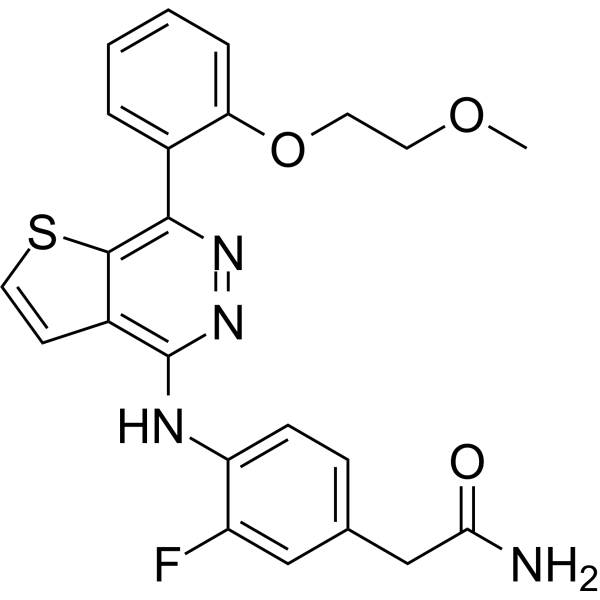
|
| DC60874 | SKPer1 (XMU-MP-8) Featured |
SKPer1 (XMU-MP-8) is a small-molecule degrader of SKP2 that triggers degradation of the oncoprotein SKP2 and specifically kills SKP2-expressing cancer cells.
More description
|
.png)
|
| DC77410 | BMS-986449 Featured |
BMS-986449 is a CELMoD molecular glue and an IKZF2/IKZF4 degrader. BMS-986449 targets the degradation of transcription factors Helios (IKZF2) and Eos (IKZF4) in regulatory T (Treg) cells. BMS-986449 redirects the E3 ubiquitin ligase Cereblon to induce the degradation of Helios and Eos, reprogramming Treg cells and enhancing antitumor immunity. BMS-986449 is promising for research of advanced solid tumors.
More description
|
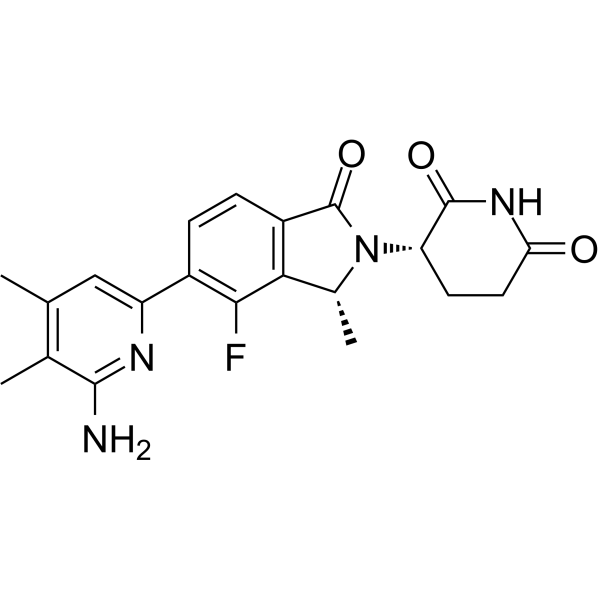
|
| DC67412 | MRT-3486 Featured |
MRT-3486 (Compound 5) is a cereblon-based NEK7 molecular glue degrader. MRT-3486 can be used for autoinflammatory diseases research.
More description
|
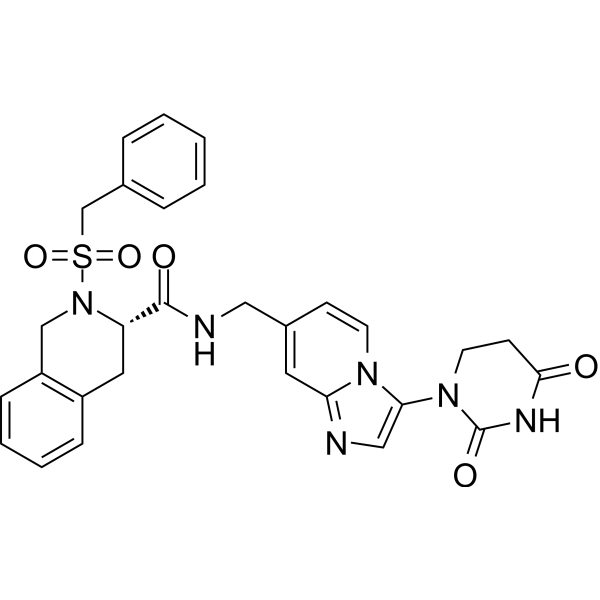
|
| DC60852 | PVTX-405 Featured |
PVTX-405 is a potent, effective, highly selective, and orally efficacious IKZF2 molecular glue degrader with DC50 of 0.7 nM. PVTX-405 in combination with anti-PD1 or anti-LAG3 significantly increases animal survival compared to anti-PD1 or anti-LAG3 alone.
More description
|
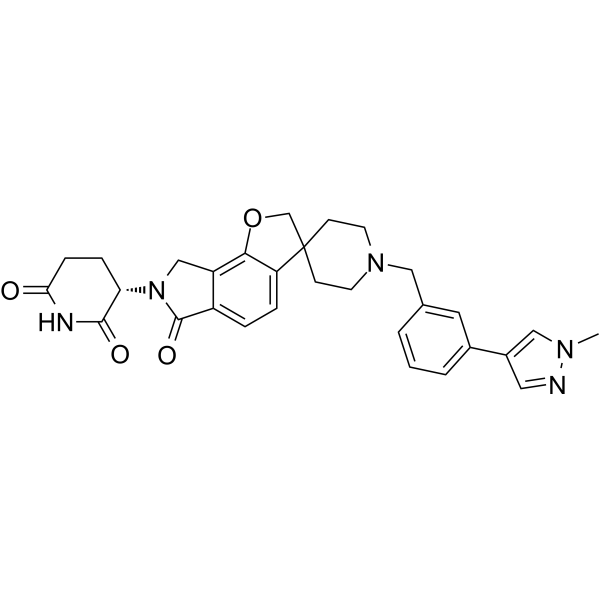
|
| DC77747 | TCIP3 |
TCIP3 is a bivalent molecular glue with with dual binding to p300/CBP and BCL6. TCIP3 redirects p300 and CBP to activate programmed cell death genes normally repressed by the oncogenic driver, BCL6. TCIP3 can be used for the study of diffuse large B cell lymphomas (DLBCLs). TCIP3 exhibits no toxicity in non-transformed tonsillar lymphocytes or fibroblasts.
More description
|

|
| DC77636 | NK7-902 |
NK7-902 is a CRBN molecular glue degrader of NEK7. NK7-902 fully degrades NEK7 in human primary monocytes and whole blood but only partially inhibits NLRP3-dependent IL-1β production. NK7-902 leads to profound and long-lasting NEK7 degradation but only transiently blocks NLRP3 inflammasome activation in non-human primates by oral administration. NK7-902 shows activity in murine systems.
More description
|

|
| DC77607 | MNN-02-155 |
MNN-02-155 is a bivalent molecular glue with with dual binding to p300/CBP and BCL6. MNN-02-155 induces potent activation of the BCL6-target reporter gene and cell death. MNN-02-155 can be used for the study of diffuse large B cell lymphomas (DLBCLs).
More description
|

|
| DC77547 | KMG-1068 |
KMG-1068 (Compound 4a), a molecular glue, is a GSPT1/2 degrader. KMG-1068 effectively induces the CRBN-dependent degradation of GSPT1/2 by binding to the IMiD binding site on CRBN, facilitating the formation of a ternary complex with GSPT1/2. KMG-1068 is promising for research of cancers.
More description
|

|
| DC77477 | DEG-35 |
DEG-35 is a CRBN-dependent, dual IKZF2 and CK1α molecule glue degrader, with DC50 values of 1.4 nM and 4.4 nM for CK1α and IKZF2, respectively. DEG-35 activates the p53 apoptosis pathway. DEG-35 can be used in the research for Acute Myeloid Leukemia (AML).
More description
|

|
| DC77432 | CB039 |
CB039 is a selective a molecular glue degrader that targets RBM39 (RNA-binding protein 39). CB039 promotes the formation of a ternary complex between RBM39 and the E3 ubiquitin ligase CUL4-DCAF15, leading to proteasomal degradation of RBM39. CB039 is promising for research of cancers with RBM39 dependency, such as acute myeloid leukemia (AML) and ovarian cancer.
More description
|

|
| DC77373 | AMPTX-1 |
AMPTX-1, a molecular glue, a potent and selective, reversibly covalent BRD9 degrader via recruitment of BRD9 to the E3 ligase DCAF16.
More description
|

|
| DC60863 | D223 (DS02312223) Featured |
D223 is a molecular glue and promotes glucose uptake in the absence of insulin. D223 also increases the affinity of RAS binding to PI3Kα by ~500-fold.
More description
|
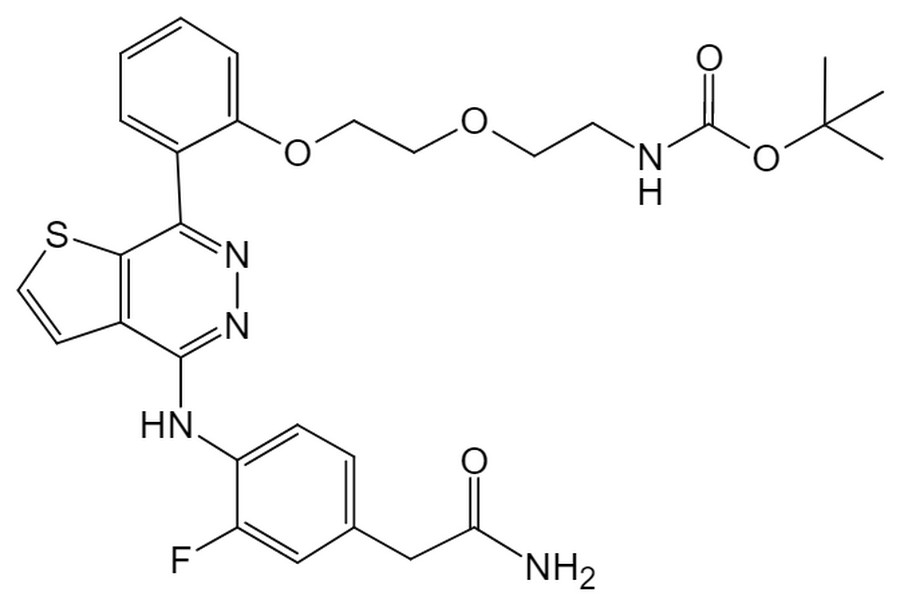
|
| DC65817 | VHL-CDO1 glue degrader ( Compound 4) Featured |
Compound 4 (VHL-CDO1 glue degrader) is a molecular glue degrader for cysteine dioxygenase 1 (CDO1) by recruiting it into the Von Hippel-Lindau (VHL) E3 ligase complex and leading to its selective degradation.
More description
|

|
| DC73166 | Cyclin K degrader DS17 |
Cyclin K degrader DS17 is a selective cyclin K molecular glue degrader with TR-FRET EC50 of 19 nM.
More description
|

|
| DC67333 | MYC degrader 1 TFA Featured |
MYC degrader 1 TFA (compound A80.2HCl) is an orally available molecular glue degrader targeting MYC, exhibiting significant anti-tumor activity. It restores pRB1 protein function and re-establishes the sensitivity of MYC-overexpressing cancer cells to CDK4/6 inhibitors.
More description
|

|
| DC67357 | KT-333 diammonium Featured |
KT-333 diammonium is a molecular glue degrader that selectively targets STAT3 for proteasomal degradation by bridging interactions between STAT3 and the VHL E3 ubiquitin ligase complex. Exhibiting high specificity for STAT3 degradation, this compound demonstrates potent antitumor efficacy. Its therapeutic potential is particularly relevant in hematologic malignancies, including large granular lymphocytic leukemia (LGL-L), peripheral T-cell lymphoma (PTCL), and cutaneous T-cell lymphoma (CTCL).
More description
|

|
| DC67355 | Pomalidomide-d4 Featured |
Pomalidomide-d4 is a deuterium-labeled analog of pomalidomide, a third-generation immunomodulatory drug functioning as a molecular glue degrader. This compound selectively binds the cereblon E3 ubiquitin ligase complex, triggering targeted proteasomal degradation of Ikaros family transcription factors—a key mechanism underlying its therapeutic activity.
More description
|

|
| DC67366 | KT-333 ammonium Featured |
KT-333 ammonium (Compound A) is a targeted molecular glue degrader that induces STAT3 protein degradation via the ubiquitin-proteasome pathway. The compound facilitates this process by simultaneously engaging both STAT3 and the VHL E3 ubiquitin ligase, demonstrating remarkable degradation selectivity. With potent antitumor efficacy, KT-333 ammonium shows particular promise for investigating therapeutic interventions in hematologic malignancies, including large granular lymphocytic leukemia (LGL-L), peripheral T-cell lymphoma (PTCL), and cutaneous T-cell lymphoma (CTCL).
More description
|

|
| DC67393 | Pomalidomide-d5 Featured |
Pomalidomide-d5 is a deuterium-stabilized isotopologue of pomalidomide, a third-generation immunomodulatory drug that functions as a molecular glue degrader. This compound mediates targeted protein degradation by recruiting the cereblon E3 ubiquitin ligase to promote ubiquitination and proteasomal elimination of Ikaros family transcription factors (IKZF1/3), a mechanism central to its therapeutic activity.
More description
|

|
| DC67330 | MYC degrader 1 Featured |
MYC degrader 1 (compound A80.2HCl) is an orally available molecular glue degrader targeting MYC, with significant anti-tumor activity. It restores pRB1 protein function and re-establishes the sensitivity of MYC-overexpressing cancer cells to CDK4/6 inhibitors.
More description
|

|
| DC67337 | VNPP433-3β Featured |
VNPP433-3β is a first-in-class molecular glue degrader that simultaneously targets androgen receptor (AR), its splice variants (AR-Vs), and Mnk1/2 kinases for proteasomal degradation. This multimodal agent demonstrates potent anti-proliferative activity in castration-resistant prostate cancer (CRPC) models, with GI50 values of 0.2–0.31 μM in LNCaP, C4-2B, and CWR22Rv1 cells. Its robust in vivo efficacy, evidenced by tumor growth inhibition in CWR22Rv1 xenografts, is supported by favorable pharmacokinetics in CD-1 mice.
More description
|

|
| DC60858 | LC-04-045 Featured |
LC-04-045 is a leading NEK7 molecular glue degrader with DC50 of 7 nM and Dmax of 90 % in MOLT-4 cells. LC-04-045 displays high selectivity for NEK7 across the proteome.
More description
|

|
| DC67361 | IKZF-IN-1 Featured |
IKZF-IN-1 (Compound I) is a molecular glue degrader that selectively targets IKZF1/2/3/4 (Ikaros zinc finger family proteins) for proteasomal degradation. This immunomodulatory compound holds therapeutic potential for investigating cancer and viral infection treatment strategies.
More description
|

|
| DC67362 | QXG-6442 Featured |
QXG-6442 is a potent molecular glue degrader targeting CK1α, demonstrating high degradation efficiency (DC50 = 5.7 nM, Dmax = 90%). This compound significantly suppresses proliferation in the MOLM-14 leukemia cell line, highlighting its therapeutic potential.
More description
|

|
| DC60451 | MRT-2539 Featured |
MRT-2359 a potent, selective and orally bioavailable GSPT1-directed molecular glue degrader (MGD).
More description
|

|
| DC67377 | JP-2-249 Featured |
JP-2-249 functions as a molecular glue degrader that selectively targets SMARCA2 for proteasomal degradation. In MV-4-11 leukemia cells, treatment with JP-2-249 (1–10 μM) induces dose-dependent reduction of SMARCA2 protein levels, demonstrating potent degradation activity.
More description
|

|
| DC73179 | SW394703 |
SW394703 is a novel DDB1-dependent molecular glue degrader for cyclin K, SW394703 is toxic to HCT116 cells (IC50=1.2 uM).
More description
|

|
| DC66609 | PLX-4545 Featured |
PLX-4545 is an orally bioavailable molecular glue degrader that hijacks the cereblon E3 ubiquitin ligase complex to selectively target IKZF2 (Helios), a zinc finger transcription factor critical for regulatory T cell (Treg) function. By inducing proteasomal degradation of IKZF2, PLX-4545 disrupts Treg stability and reprograms these immunosuppressive cells into pro-inflammatory effector-like T cells, effectively shifting the tumor microenvironment toward immune activation.
More description
|

|
| DC74482 | CC-3240 Featured |
CC-3240 is an optimized molecular glue degrader derived from CC-8977, demonstrating high-affinity binding to CaMKK2 (IC50 = 9 nM) and potent degradation efficacy (DC50 = 100 nM in THP1 cells, Dmax = 92%). This novel compound effectively hijacks the ubiquitin-proteasome system to induce targeted CaMKK2 depletion, offering a superior pharmacological approach over traditional kinase inhibition.
More description
|

|